Text Version of the Flooded Home
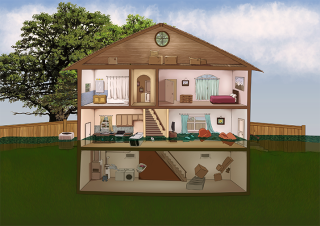
Tour EPA’s virtual flooded home to learn how to safely reenter and clean up your home after a flood.
Take the interactive flooded home tour or view the text version below.
On this page:
Flooded Home
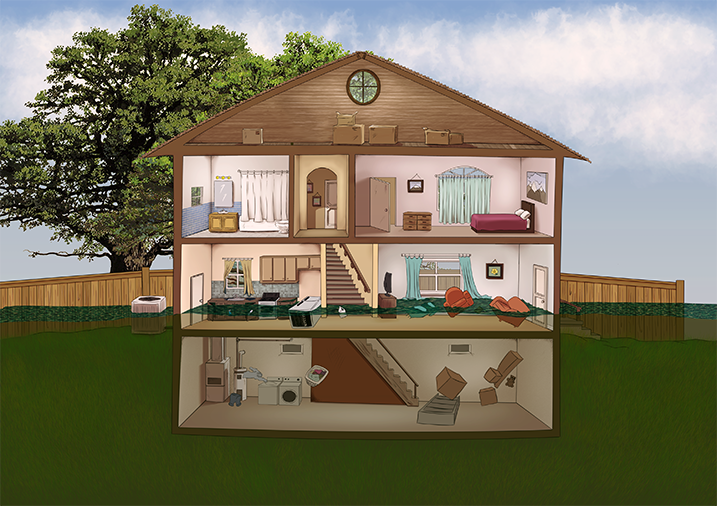
1. Entrance

You and your family should wait to reenter your flooded home until professionals tell you it is safe. Make sure the electricity is off and look out for structural or other hazards.
Bring protective clothing and gear with you into the house. Remember to put on protective clothing before entering. At a minimum, wear an N95 respirator, goggles without holes, gloves, and clothing that covers exposed skin. If there is standing water, wear gear such as boots and waders to protect yourself from hazards.
People with breathing problems, like asthma, or weakened immune systems should stay away from moldy sites. Children and elderly individuals should not take part in disaster cleanup work.
2. First Floor

You should assume you have mold growth if you were not able to dry your flooded home, including furniture and other belongings, within 24–48 hours.
Flood water may have carried sewage or chemicals into your home.
3. Second Floor

Contact your insurance company and take pictures of your home and belongings before you start cleanup activities.
4. Basement

Cleanup may be too difficult or dangerous for you. It may be best to get help from qualified professionals if you can.
Muck-Out
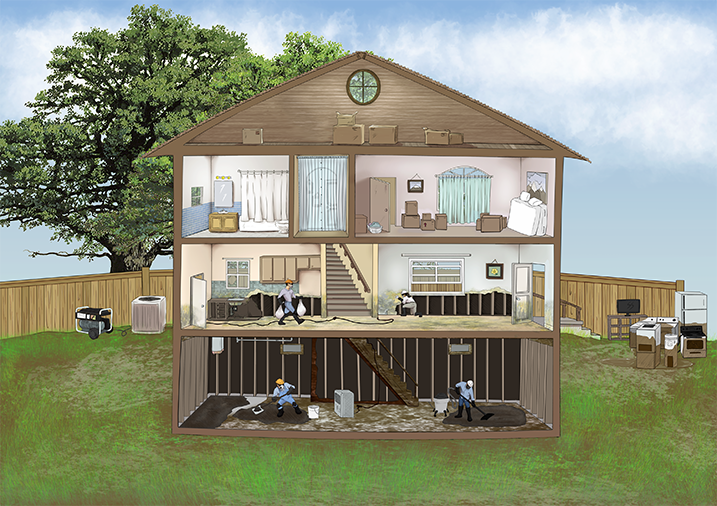
1. Back Yard

Use fuel-powered portable generators carefully to avoid carbon monoxide poisoning and fires.
Place the generator:
- Outside and at least 20 feet away from any building. Ensure it does not exhaust into open doors and windows.
- Away from standing water and wet areas.
- Elevate it, if necessary, to avoid electrical hazards.
2. Entrance

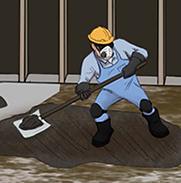
Wear personal protective equipment when you enter your flooded home. At a minimum, wear protective gloves, an N95 respirator, and goggles without holes.
After you leave a moldy site, shower and change your clothes. If you can, keep contaminated clothing out of uncontaminated areas, including your current living quarters.
Do not turn on your HVAC system until you have completed all the steps to clean and dry the home and have addressed needed repairs and remediation.
3. Basement

Remove standing water and take steps to make working in the house safe from structural, electrical, and physical hazards, including slips, trips and falls.
4. First Floor

Dry your home and everything in it as quickly as you can - within 24-48 hours. Open all doors and windows when you are working and leave as many open as is safe when you leave.
Ensure fuel-powered portable generators are placed outside at least 20 feet away from any building and does not exhaust into open doors and windows.
Remove standing water and wet materials. Throw away items that can’t be cleaned and dried. Place wet and moldy items in plastic bags to throw away or to clean and dry later.
5. Second Floor

Isolate unaffected areas using plastic sheeting. Open windows, cover vents, and do not turn on the HVAC system. Debris in the HVAC system, including mold spores, could spread into unaffected areas.
Remove and place clothing in a plastic bag before you enter an unaffected area, and shower to remove mold spores and other possible pollutants from hair and skin.
6. Front Yard

Sort debris and place it curbside for removal.
Clean and Dry
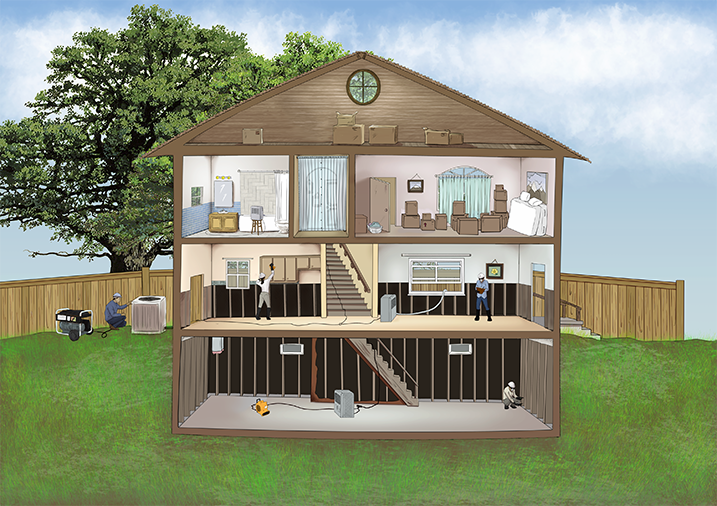
1. Back Yard

Use fuel-powered portable generators carefully to avoid carbon monoxide poisoning and fires.
Ensure all fuel-powered portable generators are:
- Outside and at least 20 feet away from any building.
- Not exhausting into open doors and windows.
- Away from standing water and wet areas.
- Elevated, if necessary, to avoid electrical hazards.
2. First Floor

Keep your protective clothing on while you clean. At a minimum, wear an N95 respirator, goggles without holes, and protective gloves. Clean with water and detergent. Remove all mold you can see. In most cases, cleaning with water and a detergent is sufficient to remove microorganisms. Dry right away.
If you choose to use cleaning products, use them carefully and in a well-ventilated space. DO NOT mix cleaning products together.
3. Attic

Cleaning and drying your air ducts and other parts of your HVAC system can be complicated. If you can, hire a professional to do this for you.
4. Second Floor

Open access to the attic to let air flow into it. Before you open the attic door, make sure the access is clear of debris. Items may have shifted since the last time someone opened it
5. Basement

When electricity is safe to use, use portable fans and dehumidifiers to remove moisture. Portable high-volume HEPA-filter fans and air cleaners can help circulate and clean the air.
If mold has already started to grow, do not use fans, which may spread the mold. Clean all visible mold before using fans.
If the flood affected any part of your air ducts or HVAC system, do not use it to dry until a professional tells you it is safe.
Cleaned and Repaired Home
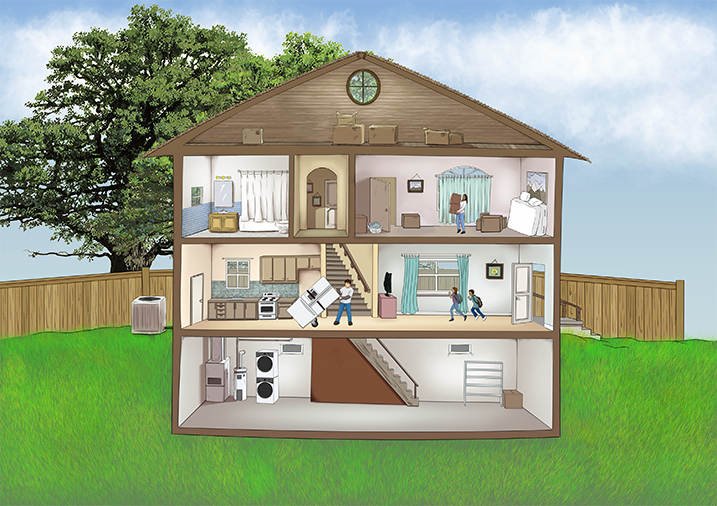
1. Entrance

Ensure the cleanup is complete before reoccupying your home. You may need to ask a qualified remediation or restoration professional to know whether your cleanup is complete.
The home is likely ready for safe reoccupation when:
- Materials that cannot be cleaned and dried have been removed.
- Essential equipment has been replaced.
- The house and everything in it has dried.
- The remaining surfaces and materials have been cleaned.
2. First Floor

If you have health problems that get worse when you return home – like asthma attacks; allergy attacks; or skin, eye or throat irritation – there may still be mold or other flood-related pollutants inside. Sampling for mold is not usually recommended; instead, perform a careful inspection of the home, including the HVAC system. Ensure that the area is dry and free from visible contamination, dust, and musty odors.
3. Second Floor

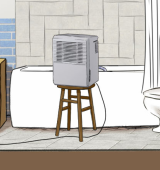
If your home is clean and safe, you should be able to safely turn on your HVAC system. You may still need to monitor the humidity inside (make sure it is below 60 percent, ideally between 30–50 percent) and consider buying a dehumidifier.
4. Basement

If you still see or smell mold, you have more work to do. After remediation, there should be no signs of water damage or mold growth. Residents should be able to occupy the home without experiencing illness.
